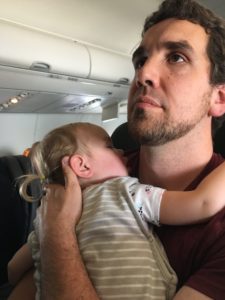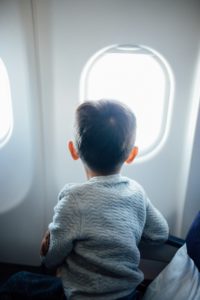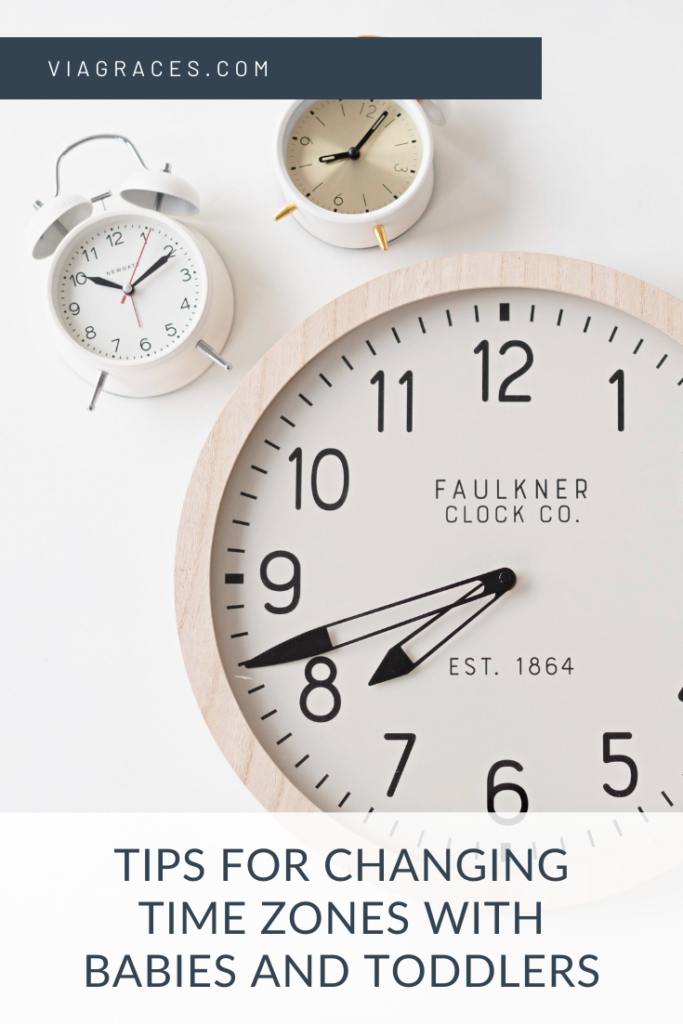Traveling with young kids can be challenging enough (trips not vacations, right??), not to mention changing time zones and dealing with a jet lagged baby or toddler. It can be rough!
But that doesn’t mean changing time zones with kids is impossible, and I certainly don’t want you avoiding family vacations and all of those sweet memories because you’re afraid of the jet lag.

So let’s dig into my top tips about how to handle time zone changes with your babies, toddlers, and older kids, including:
- When to start adjusting your baby or toddler to the new time zone
- Tips for helping kids adjust to the new time zone
- How to adjust your child’s schedule when traveling from the east coast to the west coast, or from the west coast to the east coast
- What to expect when changing time zones internationally
We’ll start with general tips that will even help you adjust to the new time zone, and then we’ll get even more specific by age group.
When to Start Adjusting Your Baby to the New Time Zone
WHEN YOU GET THERE!
A lot of people ask if they should start adjusting to the new time zone before they leave, and my answer is nope! And I say that for a few reasons…
First, your travel plans may change. Your flights might be delayed, they might get canceled, or your trip might get canceled and rescheduled. I certainly don’t wish these changes on anyone, but if we start making adjustments to our children’s sleep before we leave and something changes, we’re left a bit stuck and in limbo of how to move forward.
It’s also just impossible to practice a new time zone prior to traveling, because everything you do at home is based on the time of day – when you wake up, eat meals, go to the playground, etc. And because there aren’t any environmental changes happening yet, it likely just won’t work.
General Tips to Help Babies and Children Adjust to a New Time Zone
Travel Day = Anything Goes
If you’re anything like me, you’ll do everything in your power to plan your travel day, including when your little one will sleep. And it’s helpful to come prepared, but we also need to be okay if our day does not go according to plan – your child may fall asleep sooner than usual, much later than usual, or they may skip a nap altogether – and that’s okay!
If your kiddo is normally an independent sleeper at home, you may have to help them a lot more, while flying, especially. If you need to feed your baby to sleep, give them a pacifier, rock them, etc, do it! An assisted nap (even if short!) is much better than no nap at all.
Read here for more tips when it comes to helping your little one sleep on an airplane. Read here for my best road trip tips.

Jump into the New Time Zone as Quickly as Possible
It may seem daunting, but jumping into the new time zone as quickly as possible will not only be helpful for your little ones, but for you, as well!
If necessary to do an early bedtime, try not to put your child to bed more than an hour earlier than you would at home, in attempts to avoid an extra early morning. For example, if your child usually goes to bed at 7 pm EST, try not to put them to bed before 6 pm PST.
Similarly, try not to start the day more than an hour earlier than usual. For example, if your child usually wakes up at 7 am EST, try not to start the day before 6 am PST.
Continue reading for more specific jet lag tips by age!
Get Outside!!
Light (or lack thereof) will be your best friend in order to help your child (and you!) overcome jet lag and adjust to the new time zone.
If you’re able to, plan on spending some time outside shortly after arriving to your new destination to help your child’s body acclimate. If it’s still daylight, maybe go for a swim, go for a walk, bike ride, etc. If it’s night time, take a little stroll so your child’s body can register it’s night time, and then head to bed.
Additionally, try to get outside every morning and in the late evening to help your child’s body clock continue acclimating to the new time zone.
Sleep Environment
Just as it is at home, setting up as close to a “perfect” sleep environment when traveling is so important, and it’s all the more important when changing time zones.
Whether you’re traveling East to West, or West to East, having your child’s new sleep environment pitch black will help them fall asleep when it’s still light outside, or continue sleeping after sun rise. (Read here for my favorite blackout solutions, whether at home or traveling.)
Additionally, bring the sound machine! White noise is not only a familiar and helpful sleep prop your child is used to sleeping with, but it will also help muffle any new sounds while away.
For example, maybe you’re in a hotel near the airport, an AirBnb by a major road, or a train is nearby and your little one isn’t used to all of those sounds. Or maybe you’re staying in a big house with several family members or friends who are all on a different schedule…having that sound machine will help keep your child keep sleeping!
Familiar Items
Whenever traveling, it’s so helpful to make the new sleep environment feel as similar to home as possible. Not only do we want to create a dark and quiet space, like I explained above, but we want to bring familiar items from home.
If you’re traveling with a newborn, make sure you bring their swaddle! And if your baby or toddler still wears a sleep sack, bring it with you.
Similarly, if your child is 12+ months and sleeps with some sort of lovey or stuffed animal, bring that along to give them that extra piece of comfort in a new environment.
Finally, we always bring a handful of our girls’ favorite bedtime books, even when staying with a friend or family member who has plenty of great children’s books, themselves. Any little pieces of home you can bring with you that may connect to your child’s sleep is helpful.

Consistent Routines
Your child’s nap and bedtime routine are so important to not only cue their mind that they’re transitioning to sleep, but to also cue their bodies that sleep is coming.
At bedtime, their physical body will start releasing melatonin, which makes it easier to fall asleep at bedtime, and a consistent bedtime routine helps that natural process move along.
So while changing time zones, sticking to your child’s regular nap and bedtime routines is crucial to helping their body catch on to the fact that it’s time for sleep.
Changing Time Zones with Babies
Babies Following Awake windows
If your baby is taking three or more naps a day, keep following those awake windows!
For example, if you have a five month old, their regular schedule may look something like this:
- 7 am wake up
- 1.75 hours awake
- Nap 1
- 2-2.25 hours awake
- Nap 2
- 2-2.25 hours awake
- Nap 3
- 2.5 hours awake
- 7 pm bedtime
So keep following those awake windows as closely as traveling allows (I’m sure it won’t be perfect!), but now try to base bedtime on the new time zone.
If you’re traveling East Coast to West Coast, that might look something like:
- 7 am wake up
- 1.75 hours awake
- Nap 1
- 2-2.25 hours awake
- Nap 2
- 2-2.25 hours awake
- Nap 3
- 2.25 hours awake
- Nap 4 (Cat nap so baby doesn’t treat it like bedtime!)
- 7 pm bedtime (10 pm body clock time)
[If you have no idea what awake windows are, or are having trouble figuring out the best schedule for your baby, go snag my free Ultimate Guide to Sleep Schedules to help!]
Babies on a Set Nap Schedule
If your baby is 7+ months or older, they are likely on a two nap schedule, and the exciting thing about two nap schedules is your baby can handle a set schedule!
Additionally, as your baby is older now, they can handle being pushed beyond their normal schedules better than younger babies can, which is helpful for changing time zones.
If your baby really didn’t sleep well while flying or driving and there are still a few hours left in the day when you arrive, see if you can sneak in a cat nap to help tide them over to bedtime. And if they take the nap, great! Let’s aim for a 7-8 pm bedtime according to the new local time.
If they just won’t nap, you’ll have to do an early bedtime, but try not to make it any earlier than 6 pm local time.
Changing Time Zones with Toddlers and Older Kids
For our toddlers on a one nap schedule, or older kids who don’t nap anymore, we have so much more flexibility! This is not to say they won’t still struggle with jet lag, but their little body clocks are easier to sway because they can handle being awake longer than usual.

If you’re traveling from the East Coast to the West Coast, try to keep your toddler or older child engaged and entertained in order to make it to bedtime. You can go for a swim, kick a soccer ball, check out the new town, visit with family, etc. – and aim to put them to bed according to your new time zone!
(Avoid screen time, as it will likely lull your child to sleep too early!)
If you’re traveling from the West Coast to the East Coast, we still want to hop into the new time zone as quickly as possible, which means putting your child to bed earlier than normal (9 pm EST feels like 6 pm PST). Lots of physical activity and time outside (specifically as the sun is setting and once it’s set) will help your child adjust.
This is also where having boundaries around bedtime will come into play, so even if your child isn’t as tired as usual, they know it’s time to stay in bed.
How to Handle the Mornings when Changing Time Zones
East Coast to West Coast
If you’re traveling East Coast to West Coast, there’s a good chance your child’s natural body clock will wake them up around 7 am EST, but it’s only 4 am PST. Try as best as you can to keep your little one in their dark and quiet room until as close to 6 am local time as possible.
If your little one wakes up and is fairly content but simply awake, let them be! If, however, your little one wakes up and is having a tough time (understandably so!), go help them, but try to keep lights off, sound machine on, and interaction as minimal as possible.
I remember this very scenario happening when we traveled out West for a family vacation when Olivia was just under two, and she woke up around 4 am our first day there. There was no way I was letting her get up to start the day, because we’d never adjust to the new time zone that way, but I also knew she wouldn’t just be able to hang by herself.
So I went into her room (kept it dark and white noise on!), sat next to her pack ‘n play, and sang her sleep song on repeat. This lasted for a solid 30-45 minutes, until she was getting antsy and I was just so sleepy. I then actually pulled her into bed with me to see if she’d fall back asleep, and we both slept for an hour or so.
When she woke up, is was close to 6 am so we got up and started the day. The next day, she woke up closer to 5:30 am, and by the third day she was back to a 7ish wake up.
West Coast to East Coast
Oppositely, if you’re traveling West Coast to East Coast, your child will likely still be sleeping come 7 am EST (as it feels like 4 am PST). This is of course dependent on what time your child went to bed the night before, but I would try not to let them sleep past 8 am EST, in order to help them jump into the new time zone more quickly.
Changing Time Zones with Babies and Children Internationally
If traveling outside of your country and the time change will be 10-12 hours different, try to jump into the new schedule within 1-2 days, though know that your child may not be fully acclimated for a few more days.
What to Expect
First of all, the first night is often the easiest because everyone is so exhausted from traveling. So if your little one has a great first night, yay! Just know that the next couple of nights may not go as smoothly.
When adjusting to international time change, it is common for anyone to wake up in the middle of the night and just be wide awake; our bodies think it’s the middle of the day!
So if your child wakes in the night and is just plain awake, let them be awake for about an hour. Take them out of their bed but keep the lights low and interactions minimal (we still want to override their little body clock!), but let the sleep pressure build back up a bit before actively helping them get back to sleep.
This may happen for 2-3 nights and that’s normal!

How to Adjust Back Home
When I lived and worked overseas, I often had a much easier time adjusting to the new time zone going there, and I really struggled with jet lag whenever I came home.
This is often the case when we adjust to new time zones with babies and kids, as well.
One reason is due to the sleep debt we often accrue when traveling. Our kids are probably “off schedule” to some extent when traveling, whether that be more naps on the go, skipped naps, later bedtimes, earlier mornings, etc.
Due to this accrued sleep debt, you may notice your baby, toddler, or older child sleeping more than usual when you get home, and that’s okay! I normally suggest parents wake their little ones up once they’ve slept 12 hours overnight, but if you’ve just returned from traveling and your child is still asleep after 12 hours, let them sleep!
And try to keep those first couple of days back home less busy than usual so everyone can rest, recover, and get back into your normal routine. Before you know it, you’ll be back to business as usual!
Conclusion
Changing time zones and dealing with jet lag is tough enough for adults, let alone our babies and kids who just don’t understand what’s going on!
In all of this, my top three tips are:
- Jump into the time zone ASAP!
- Get outside!
- Give yourself lots of GRACE!
You can do this, and it’s worth the memories.
For more tips for traveling with kids, check out our comprehensive travel sleep guide! The guide has all of this info plus so much more. Tips for plane travel, car travel, hotel stays, what to do when sleep is hard, how to adjust back home, etc, to help you feel confident traveling with your kids.
With Grace,
Lauren
